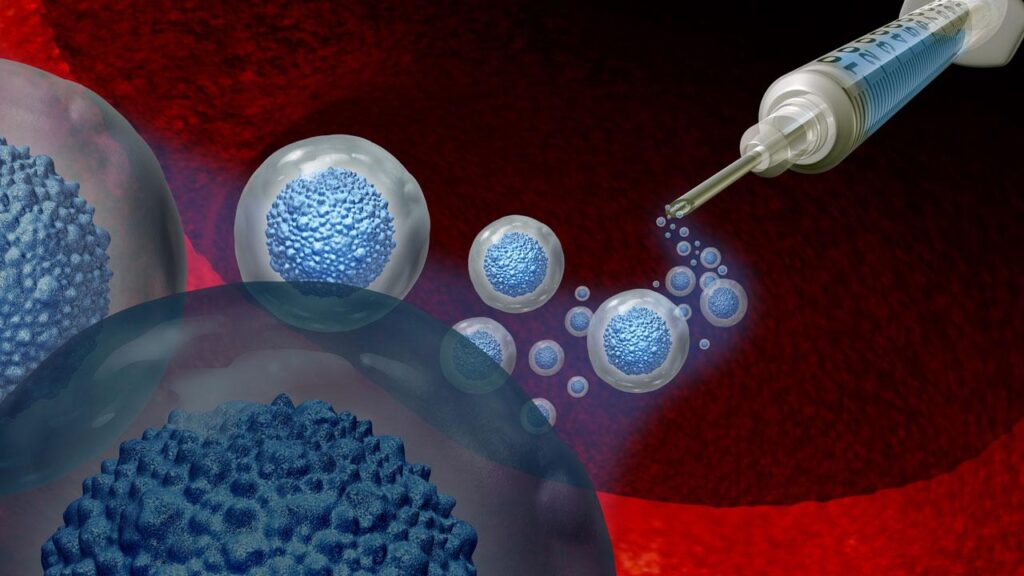Stem cell method in the fight against leukaemia

Stem cell transplantation is one of the ways of treating leukaemia, which is a common type of cancer, especially in children. Many children regain their health with this procedure, which does not cause any harm to the donor. For this, stem cell donation is of great importance.
Leukaemia accounts for almost one third of cancers seen in childhood. Leukaemia, popularly known as “blood cancer”, is most commonly seen between the ages of 1-5.
Leukaemia has many symptoms. Chief among these are weakness, fatigue, paleness, quick fatigue, palpitations, persistent fever, loss of appetite, weight loss, frequent recurrent infections, swelling of the lymph nodes, unexpected bruising on the skin, pain, swelling and limitation of movement in bones and joints. Families who notice these symptoms should take their children to a physician without delay.
Leukaemia is a disease with a high success rate in treatment if diagnosed early. Depending on the patient’s condition, chemotherapy and bone marrow transplantation are followed in the treatment process. We talked to Dr Emine Gültürk, Faculty Member of the Department of Haematology at the University of Health Sciences Bakırköy Dr. Sadi Konuk Training and Research Hospital, Dr. Emine Gültürk, about bone marrow (stem cell) transplantation, which is an effective method in the treatment of leukaemia.
Stem cell transplantation is preferred over bone marrow
Instead of bone marrow transplantation, stem cell transplantation, which is a simple procedure, is now preferred. Dr. Gültürk explains the difference of this method from bone marrow transplantation as follows
“Without any surgery or procedure from the bone marrow, we only make a needle and make the stem cells pour into the peripheral blood with the method we call growth factor. Then we collect stem cells from the blood. In other words, it is no longer bone marrow, but the patient’s stem cells are collected and this donation process is performed.”
In the treatment with stem cell method, first of all, the patient’s relatives such as siblings and relatives are started to work with relatives who can be compatible. If the expected compatibility is not found, stem cells given through donation come into play.
Thanks to this method, which is used in the treatment of many diseases, especially leukaemia, many patients, both children and adults, regain their health. Therefore, stem cell donation is of great importance.
What are the conditions for stem cell donation?
So who can donate stem cells? First of all, you must be between the ages of 18-50 to donate stem cells. The donor must not have Hepatitis B, Hepatitis C and Syphilis. In addition to not having a chronic disease, other conditions required are not having a diagnosis of cancer or HIV (AIDS).
Underlining that stem cell donation is a very simple process, Dr. Gültürk said, “The Red Crescent has certain centres. You go to those centres and donate by giving three tubes of blood. Then it is investigated whether the donor has any disease. A match is made according to the blood group and tissue compatibility,” she says.
“The donor may only have bone pain for 2-3 days due to the needles given during the peripheral stem cell collection method. The reason for this is that the growth factors we administer activate the bone marrow. We minimise bone pain by giving painkillers. In short, the procedure has no harm to the donor.”
Dr Emine Gültürk, Faculty Member of the Department of Haematology at the University of Health Sciences Bakırköy Dr. Sadi Konuk Training and Research Hospital

Stem cell transplantation does not harm the donor
If the donated stem cells match the patient, the transplantation process is initiated. One of the most common questions in this regard is the health problems that the donor may experience during or after the transplantation process. Underlining that this process does not harm the donor, Dr Gültürk continues his words as follows:
“This is a treatment method that has been done for years. The donor may only have bone pain for 2-3 days due to the needles given during the peripheral stem cell collection method. The reason for this is that the growth factors we administer activate the bone marrow. We reduce bone pain by giving painkillers. In short, the procedure has no harm to the donor.”
The donor does not need to be hospitalised before and after the stem cell transplantation procedure and anaesthesia is not required. The bone marrow method is performed under anaesthesia.
Another curious detail is whether the donated stem cells renew themselves or not… Dr Gültürk said, “The stem cell regenerates itself quickly in a short time. It is completely restored within a month,” says Dr Gültürk.
The great success of TÜRKÖK
The first address that comes to mind when it comes to stem cell donation in Turkey is the Turkish Stem Cell Centre, which is known as “TÜRKÖK”. Since 2015, TÜRKÖK has been bringing together patients waiting for bone marrow transplantation and donors. To date, approximately 1 million people have become stem cell donors thanks to the TÜRKÖK Project.






